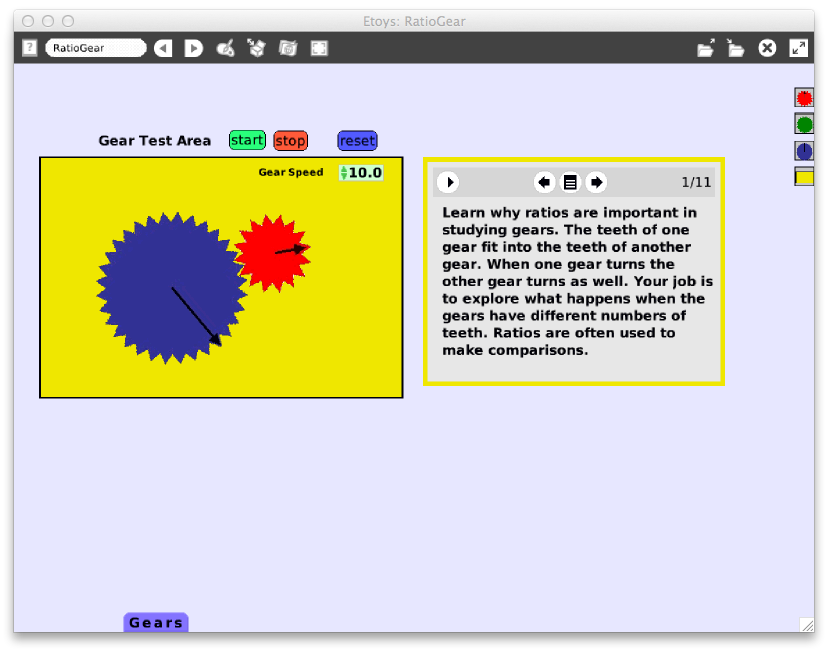Ratios
Can you Imagine the gears turning in your mind as you read this? Try to imagine little gear's cogs meshing with a big gear's cogs. What does that look like? You can Invent your own system of gears. Inspire your classmates with your knowledge of gears.

In this project we use:
text, book, buttons, test , Start Script, Stop Script, turn by, color sees
Project
Begin by downloading the project from http://etoysillinois.org/library?sl=2141.
Ratios are important in studying gears. The teeth of one gear fit into the teeth of another gear. When one gear turns the other gear turns as well. Your students can explore what happens when the gears have different numbers of teeth. Ratios are often used to make comparisons.
To start, they should
- click on the purple "Gears" flap at the bottom of the project to open it
- click on any gear and drag it into the yellow Gear Test Area, then click again to droo it into the yellow Gear Test Area
- repeat for a second gear
- put a tooth on one gear into a space between teeth on the other gear
- count the teeth in each gear and record in their notebook
To change the speed of the gears, they click on the Gear Speed number at the upper right of the Gear Test Area. It will be highlighted in darker green. Then type the new speed and press enter. You can also use the up and down arrows to change the gear speed. Have students set up a ratio to compare the number of teeth on the smaller gear to the number on the larger gear. Then they should:
- record the ratio in their notebook
- predict which gear will move faster
- record their prediction
- explain why they think this
- click start and count how many times the smaller gear turns when the other gear turns one complete turn
- click stop and reset when through
- calculate the ratio of the number of turns for the smaller gear to the number for the larger
- record the ratio in their notebook
They should repeat their experiment with other sets of two gears. There are six possibilities. Have them can list them. To do this methodically, they should start with the blue gear and list all combinations with it, then green and then red. You can give them this hint if they are stuck. Then they should record your results for the other five sets of gears.
Have them organize their data in a table to help them see relationships between the data for different gear sets. Ask them to ponder the following questions:
- What relationship can you find between the two ratios (teeth and turns) for each set?
- Does the smaller or larger gear turn faster?
- Can you explain your data?
Have your students try three gears, they will notice that one of the gears may turn the wrong way. Note that there are four different combinations of three gears. Have them try to write them down the combinations and test all the possibilities. Have them see if the can fix the problem by looking at my script. They can see my script by clicking the bottom yellow viewer tab at the upper right and dragging the "TestArea run" tile out onto the workspace. Challenge them to struggle to redesign the script to make all the gears always turn the correct direction.This will require more tests.
More Inspiration
Have your students
- think of some other uses of ratios - ratios are used by engineers and scientists
- look in their text books or on the Internet for ratio applications
- best of all think of some applications where they, their family or friends find ratios useful
- think up an idea for an application of gears
- search the Internet for information about their idea - someone may have thought of it
- make a presentation to the class using their data, observations, ideas and thoughts





